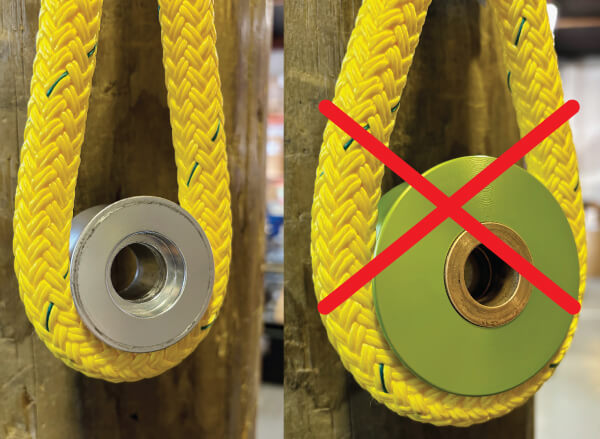Arborist rigging blocks, commonly called 'impact blocks', must be configured correctly, and failure to do so can have catastrophic consequences, apart from rendering your device, useless.
Although rigging blocks resemble pulleys and share similar characteristics, they have one significant difference. A pulley is always above the load, while an impact block, as the name suggests, allows the user to place the rigging device below the load (negative position) and then "catch" the load while it is lowered.
Rigging blocks have a double-sheave design with rounded edges. The smaller top sheave provides an optimal bend ratio and secures the block with a deadeye or loopie. Once secured, a rigging line is run through the larger bottom sheave, again providing the optimal bend ratio to retain the maximum strength of the rigging line. This design allows energy dissipation throughout the entire length of the rigging system, between the load attached and the friction control device at ground level (floating or fixed bollard).
The top connection point on an arborist rigging block is not designed to function as a pulley sheave. Unlike the bottom pulley sheave, the top connection point has no sintered bushings. If you mistakenly use the impact block in this manner, the resulting heat will weld the aluminium sheave to the stainless push-pin, seizing it and causing it to cease functioning correctly. This is not simply a warranty issue but a severe consequence of misuse (rigging misconfiguration) and is particularly dangerous when rigging structurally deficient trees.
The smaller diameter of the top connecting sheave serves another purpose. It ensures that the splice on a deadeye (the most common method of attaching the rigging black) is not spread too widely, reducing its operating strength.
The sheave or pulley wheel at the bottom of the impact block is a crucial component. It features sintered bronze bushings on the stainless spindle and provides the correct bend ratio relative to the rigging line to accommodate the loads applied and run smoothly.
Understanding the likelihood of failure in a tree rigging system, including engineered gear like ropes, blocks, and slings, as well as the tree itself (which is usually the anchor for the block and sling), requires a deep understanding of physics and should not be taken lightly. However, the fundamental issue is correctly orienting the device in the first place.

Connect the deadeye or loopie to the smaller top sheave on the rigging block only, and do not use the top sheave as a pulley (note the lack of sintered bushings in the sheave on the left).
